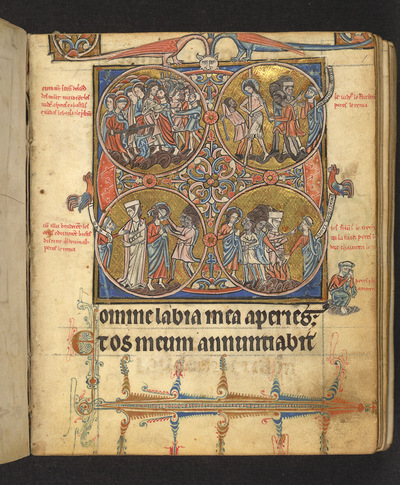Javascript must be enabled to continue!
Scenes From The Passion Of Christ, In 'The De Brailes Hours' f.1r
View through Europeana Collections
William de Brailes is the only 13th-century
English non-monastic illuminator known to have signed his work. His
surname means 'from Brailes', a town in Warwickshire, about 30
miles north of Oxford. Documentary sources reveal that he lived and
worked in Oxford, with his wife Celena, in a bookmaking community
based around the present site of the chapel of All Souls College.
His distinctive painting style has been recognised in several
manuscripts, of which this is perhaps the most important. It is the
earliest extant English Book of Hours (a book containing prayers to
be said at certain hours of the day), and includes two
self-portraits. The present first leaf of the manuscript (others
are probably missing) starts in the middle of the Passion
narrative, with the Arrest and Flagellation of Christ, the three
denials of Peter, the buffeting of Christ, and Peter's
remorse.
Title: Scenes From The Passion Of Christ, In 'The De Brailes Hours'
f.1r
Description:
William de Brailes is the only 13th-century
English non-monastic illuminator known to have signed his work.
His
surname means 'from Brailes', a town in Warwickshire, about 30
miles north of Oxford.
Documentary sources reveal that he lived and
worked in Oxford, with his wife Celena, in a bookmaking community
based around the present site of the chapel of All Souls College.
His distinctive painting style has been recognised in several
manuscripts, of which this is perhaps the most important.
It is the
earliest extant English Book of Hours (a book containing prayers to
be said at certain hours of the day), and includes two
self-portraits.
The present first leaf of the manuscript (others
are probably missing) starts in the middle of the Passion
narrative, with the Arrest and Flagellation of Christ, the three
denials of Peter, the buffeting of Christ, and Peter's
remorse.
Related Results
Christ with the Cross
Christ with the Cross
Christ holding the cross was a motif that El Greco derived from the narrative of Christ’s Passion, creating an isolated image that seems to have been extremely popular with his cli...
The Crucifixion
The Crucifixion
It was Friedländer who established the artistic personality of this anonymous artist working in Delft, and attributed the first group of works to his name. Taking his reference poi...
Mysteries of Trapani #198 | Misteri di Trapani #198
Mysteries of Trapani #198 | Misteri di Trapani #198
The Processione dei Misteri di Trapani or simply the Misteri di Trapani (in English the Procession of the Mysteries of Trapani or the Mysteries of Trapani) is a day-long passion pr...
Mysteries of Trapani #186 | Misteri di Trapani #186
Mysteries of Trapani #186 | Misteri di Trapani #186
The Processione dei Misteri di Trapani or simply the Misteri di Trapani (in English the Procession of the Mysteries of Trapani or the Mysteries of Trapani) is a day-long passion pr...
Mysteries of Trapani #187 | Misteri di Trapani #187
Mysteries of Trapani #187 | Misteri di Trapani #187
The Processione dei Misteri di Trapani or simply the Misteri di Trapani (in English the Procession of the Mysteries of Trapani or the Mysteries of Trapani) is a day-long passion pr...
Mysteries of Trapani #199 | Misteri di Trapani #199
Mysteries of Trapani #199 | Misteri di Trapani #199
The Processione dei Misteri di Trapani or simply the Misteri di Trapani (in English the Procession of the Mysteries of Trapani or the Mysteries of Trapani) is a day-long passion pr...




